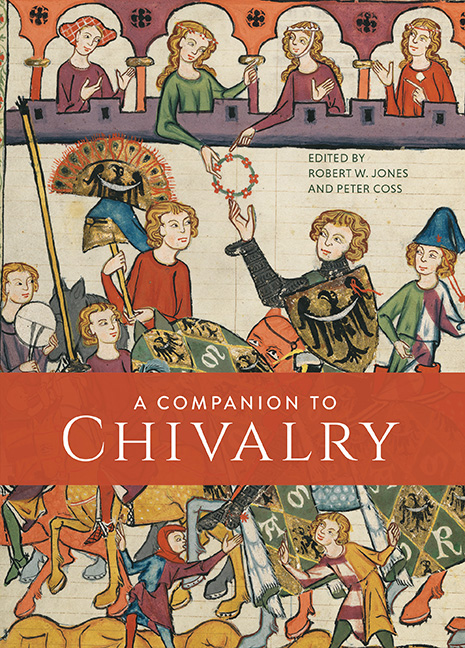Book contents
- Frontmatter
- Contents
- List of Illustrations
- List of Contributors
- Introduction
- 1 The Origins and Diffusion of Chivalry
- 2 The Organisation of Chivalric Society
- 3 The Secular Orders: Chivalry in the Service of the State
- 4 The Military Orders
- 5 Marshalling the Chivalric Elite for War
- 6 Chivalric Violence
- 7 Chivalry in the Tournament and Pas d'Armes
- 8 Heraldry and Heralds
- 9 Arms and Armour
- 10 Constructing Chivalric Landscapes: Aristocratic Spaces Between Image and Reality
- 11 Gendered Chivalry
- 12 Chivalric Literature
- 13 Manuals of Warfare and Chivalry
- 14 The End of Chivalry? Survivals and Revivals of the Tudor Age
- 15 Chivalric Medievalism
- Select Bibliography
- Acknowledgements
- Index
8 - Heraldry and Heralds
Published online by Cambridge University Press: 24 October 2019
- Frontmatter
- Contents
- List of Illustrations
- List of Contributors
- Introduction
- 1 The Origins and Diffusion of Chivalry
- 2 The Organisation of Chivalric Society
- 3 The Secular Orders: Chivalry in the Service of the State
- 4 The Military Orders
- 5 Marshalling the Chivalric Elite for War
- 6 Chivalric Violence
- 7 Chivalry in the Tournament and Pas d'Armes
- 8 Heraldry and Heralds
- 9 Arms and Armour
- 10 Constructing Chivalric Landscapes: Aristocratic Spaces Between Image and Reality
- 11 Gendered Chivalry
- 12 Chivalric Literature
- 13 Manuals of Warfare and Chivalry
- 14 The End of Chivalry? Survivals and Revivals of the Tudor Age
- 15 Chivalric Medievalism
- Select Bibliography
- Acknowledgements
- Index
Summary
The image of medieval chivalry is a grey one without the inclusion of heraldry. Indeed, the two cultural forms develop hand–in–hand, and the increasing complexity of this sign–system of individualised and hereditary iconography, borne on shield, standard and surcoat (and often, it can appear, anything else which presented a surface), can be seen to reflect the increasing formality and complexity of the chivalric order itself.
Like so much of chivalry, the origins of heraldry are far from clear, but, like chivalry, it is generally perceived as emerging in a recognisable form out of the Low Countries in the middle part of the twelfth century. It did not develop in isolation: individualised emblems on banners and shields had existed as part of a wider system of martial display, serving to mark out commanders on the battlefield. A number of Scandinavian royal households are recorded as bearing a banner with a raven on it. In many cases the banner is given an individual name, such as ravenlandeye, ‘raven, terror of the land’, supposedly the banner of Sigurd, jarl of Northumbria, or Landøyðan or ‘Land–waster’ of Harald Hardrada, which would suggest that they were individual banners. According to William of Poitiers, Harold Godwinson fought beneath the banner of ‘the fighting man’ as well as the dragon of Wessex at Hastings, whilst William, we are told, had his own distinctive banner, as well as that gifted him by the pope and presumably recognisable as such: a token of papal support against a perjurer and usurper. Fulk of Chartres, writing about the First Crusade, tells us that the three leaders of the crusading army – Robert Curthose, Baldwin of Boulogne and Bohemond of Taranto – had red, white and gold banners respectively.
Whilst Adrian Ailes is almost certainly underestimating the significance of such emblems by describing their function as simply aesthetic or bellicose, it is true that they are not heraldic in any real sense. Nor, however, are those designs of the first two decades of the twelfth century, perceived as ‘proto–heraldic’ by Ailes and others. The only distinction between them and the images that went before is that they ‘have a new orderliness about them, looking very much, like true heraldry’, but, as Ailes himself notes, ‘in the vast majority of cases there is no evidence that they held any special significance or were hereditary’.
- Type
- Chapter
- Information
- A Companion to Chivalry , pp. 139 - 158Publisher: Boydell & BrewerPrint publication year: 2019



